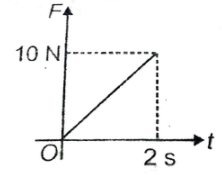A block of mass resting on a horizontal frictionless flooe is horizontally struck by a 9N force that acts for 0.02 sec. After 3 sec it receivers a second blow of force 9 N but in opposite direction which acts for 0.01 sec. The speed of the body after 30 sec is
0
3 cm/sec
90 cm/sec
30 cm/sec
The correct Answer is:B
To solve the problem step by step, we will analyze the forces acting on the block and calculate the resulting velocities after each force is applied.
Step 1: Calculate the initial velocity after the first force is applied
1. Given Data:
- Mass of the block, m=3kg
- Force applied, F1=9N
- Time duration of the first force, t1=0.02s
2. Calculate the impulse from the first force:
Impulse(J1)=F1⋅t1=9N⋅0.02s=0.18Ns
3. Using the impulse-momentum theorem:
J1=m⋅ΔV1
where ΔV1 is the change in velocity due to the first force. Since the block starts from rest, we have:
0.18=3⋅(V1−0)
V1=0.183=0.06m/s
Step 2: Determine the velocity after 3 seconds
After the first force is applied for 0.02 seconds, the block continues to move at the same velocity V1 for the remaining time until the second force is applied (3 seconds total).
- Thus, after 3 seconds, the velocity remains:
V=0.06m/s
Step 3: Calculate the effect of the second force
1. Given Data for the second force:
- Force applied, F2=−9N (opposite direction)
- Time duration of the second force, t2=0.01s
2. Calculate the impulse from the second force:
Impulse(J2)=F2⋅t2=−9N⋅0.01s=−0.09Ns
3. Using the impulse-momentum theorem for the second force:
J2=m⋅ΔV2
where ΔV2 is the change in velocity due to the second force. The initial velocity before the second force is applied is V1=0.06m/s:
−0.09=3⋅(V2−0.06)
−0.09=3V2−0.18
3V2=0.09⟹V2=0.093=0.03m/s
Final Step: Determine the speed after 30 seconds
After the second force is applied, the block will continue to move at the new velocity V2=0.03m/s for the remaining time (27 seconds) since there are no other forces acting on it.
Conclusion
The speed of the body after 30 seconds is:
Speed=0.03m/s(or 3 cm/s)
- Mass of the block, m=3kg
- Force applied, F1=9N
- Time duration of the first force, t1=0.02s
Impulse(J1)=F1⋅t1=9N⋅0.02s=0.18Ns
J1=m⋅ΔV1
where ΔV1 is the change in velocity due to the first force. Since the block starts from rest, we have:
0.18=3⋅(V1−0)
V1=0.183=0.06m/s
V=0.06m/s
- Force applied, F2=−9N (opposite direction)
- Time duration of the second force, t2=0.01s
Impulse(J2)=F2⋅t2=−9N⋅0.01s=−0.09Ns
J2=m⋅ΔV2
where ΔV2 is the change in velocity due to the second force. The initial velocity before the second force is applied is V1=0.06m/s:
−0.09=3⋅(V2−0.06)
−0.09=3V2−0.18
3V2=0.09⟹V2=0.093=0.03m/s
Speed=0.03m/s(or 3 cm/s)
Topper's Solved these Questions
- DAILY PRACTICE PROBLEMBOOK - RESONANCE ENGLISHCHAPTER - DAILY PRACTICE PROBLEMEXERCISE - DPP No.70
9 Videos
- DAILY PRACTICE PROBLEMBOOK - RESONANCE ENGLISHCHAPTER - DAILY PRACTICE PROBLEMEXERCISE - DPP No.71
10 Videos
- DAILY PRACTICE PROBLEMBOOK - RESONANCE ENGLISHCHAPTER - DAILY PRACTICE PROBLEMEXERCISE - DPP No.68
9 Videos
- CURRENT ELECTRICITYBOOK - RESONANCE ENGLISHCHAPTER - CURRENT ELECTRICITYEXERCISE - High Level Problems (HIP)
19 Videos
- ELECTRO MAGNETIC WAVESBOOK - RESONANCE ENGLISHCHAPTER - ELECTRO MAGNETIC WAVESEXERCISE - Exercise 3
27 Videos
Similar Questions
A box of mass m=2kg resting on a frictionless horizontal ground is acted upon by a horizontal force F, which varies as shown. Find speed of the particle when force ceases to act.
View SolutionA wedge of mass M resting on a horizontal frictionless surface is acted upon by a force F in the horizontal direction as shown in figure. Find the net horizontal force acting on the shaded portion of the wedge.

View SolutionA wedge of mass M resting on a horizontal frictionless surface is acted upon by a force F in the horizontal direction as shown in figure. Find the net horizontal force acting on the shaded portion of the wedge.

View SolutionA block of mass 2 kg rests on a horizontal surface. If a horizontal force of 5 N is applied on the block, the frictional force on it is (take,uk=0.4,μs=0.5)
View SolutionA body mass 2kg has an initial velocity of 3 metre//sec along OE and it is subject to a force of 4N in a direction perpendicular to OE. The distance of body from O after 4 sec will be:

View SolutionA body mass 2kg has an initial velocity of 3 metre//sec along OE and it is subject to a force of 4N in a direction perpendicular to OE. The distance of body from O after 4 sec will be:

View SolutionAn object of mass 10kg moves at a constant speed of 10 ms−1. A constant force, that acts for 4 sec on the object, gives it a speed of 2ms−1 in opposite direction. The force acting on the object is :
View SolutionA body of mass 40 gm is moving with a constant velocity of 2cm/sec on a horizontal frictionless table. The force on the table is
View SolutionA variable force acts on a body of mass 2 kg intially at rest as shown in figure . Calculate the impulse of the force in first 2 seconds and speed of the body after 2 seconds .

View SolutionA block of mass 20kg is placed on a rough horizontal plane and a horizontal force of 12N is applied. If coefficient of friction is 0.1 the frictional force acting on it is,
View Solution
